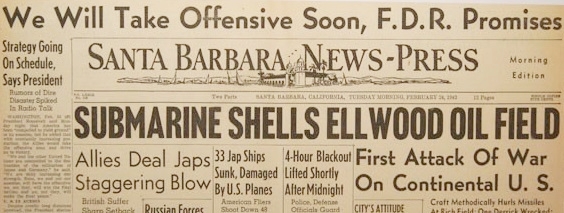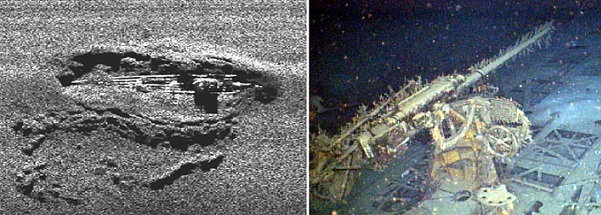by Bruce Wells | Mar 10, 2024 | Petroleum in War
Secret WWII project sent Oklahoma drillers to British oilfield, adding one million barrels of oil production by 1944.
As the United Kingdom fought for its survival during World War II, a team of American oil drillers, derrickhands, roustabouts, and motormen secretly boarded the converted troopship HMS Queen Elizabeth in March 1943. Once their story was revealed years later, they would become known as the Roughnecks of Sherwood Forest.

The 42 volunteers from Noble Drilling and Fain-Porter Drilling companies taken before they secretly embarked for the United Kingdom on March 12, 1943, aboard HMS Queen Elizabeth, which had been converted into a troop transport ship. Photo courtesy of the Guy Woodward Collection, American Heritage Center, University of Wyoming.
By the summer of 1942, the situation was desperate. The future of Great Britain — and the outcome of World War II — depended on the supply of petroleum. At the end of that year, demand for 100-octane fuel had grown to more than 150,000 barrels every day — and German U-boats ruled the Atlantic.
British Secretary of Petroleum, Geoffrey Lloyd in August 1942 called for an emergency meeting of his country’s Oil Control Board to assess the “impending crisis in oil.” (more…)
by Bruce Wells | Mar 9, 2024 | Petroleum in War
Reluctant Navy admirals switched from coal to oil — adding to engine power and simplifying resupply.
Commissioned on March 12, 1914, the USS Texas was the last American battleship built with engines to be powered with coal-fired boilers. Converted to burn fuel oil in 1925, the “Mighty T” became even more dominant at sea as the worldwide maritime change from coal to oil became another chapter of U.S. petroleum history.
When the industrial revolution ended the “Age of Sail,” coal that fired the boilers of steam-powered ships became a strategic resource. Worldwide “coaling stations” were essential at a time when oil was little more than a lubricant or a resource for making lamp kerosene. (more…)
by Bruce Wells | Feb 17, 2024 | Petroleum in War
Shelling of the Ellwood field at Santa Barbara created mass hysteria — and the “Battle of Los Angeles.”
Soon after America entered World War II, an Imperial Japanese Navy submarine attacked a refinery and oilfield near Los Angeles, the first attack of the war on the continental United States. The submarine’s deck gun fired about two dozen rounds, causing little damage — but it resulted in the largest mass sighting of UFOs in American history.

A February 1942 Imperial Japanese Navy submarine’s shelling of a California refinery caused little damage but created invasion (and UFO) hysteria in Los Angeles. Photo courtesy Goleta Valley Historical Society.
At sunset on February 23, 1942, Imperial Japanese Navy Commander Kozo Nishino and his I-17 submarine lurked 1,000 yards off the California coast. It was less than three months since the attack on Pearl Harbor, and Los Angeles residents were tense. (more…)
by Bruce Wells | Jul 27, 2023 | Petroleum in War
“Without the prodigious delivery of oil from the U. S. this global war, quite frankly, could never have been won.”
A government-industry partnership built two petroleum pipelines from Texas to the East Coast that proved vital during World War II. “Big Inch” carried oil from East Texas oilfields. “Little Big Inch” carried gasoline, heating oil, diesel oil, and kerosene.
The final weld on the “Big Inch” was made in July 1943, just 350 days after construction began. “Without the prodigious delivery of oil from the U.S. this global war, quite frankly, could never have been won,” proclaimed historian Keith Miller. (more…)
by Bruce Wells | Jul 22, 2023 | Offshore History, Petroleum in War
Routine scan of Gulf of Mexico seabed for new petroleum pipelines reveals shipwrecks.
During World War II, U-boats prowled the Gulf of Mexico to disrupt the flow of oil carried by tankers departing ports in Louisiana and Texas.
Today’s petroleum companies operating in the Gulf of Mexico’s outer continental shelf routinely provide government scientists with sonar data for areas with potential archaeological value. Federal agencies review oil and natural gas-related surveys, and over the years the data have revealed more than 100 historic shipwrecks in U.S. waters.

A 2001 archaeological survey by BP and Shell prior to construction of a natural gas pipeline confirmed discovery of U-166 about 45 miles off the Louisiana coast.
In 2001, the Minerals Management Service noted that “a German submarine definitely got our attention.”
by Bruce Wells | Jun 3, 2023 | Petroleum in War
Towed “Conundrums” spooled off steel pipe across the English Channel soon after D-Day.
To provide vital oil across the English Channel after the June 6, 1944, D-Day landings, secret pipelines were unwound from massive spools to reach French ports.
Wartime planners knew that following the D-Day invasion Allied forces would need vast quantities of petroleum to continue the advance into Europe.

The secret pipeline mission used a popular Walt Disney character for its logo.
Allied leadership also knew that petroleum tankers trying to reach French ports would be vulnerable to Luftwaffe attacks. A secret plan looked to using new undersea pipeline technologies. (more…)





